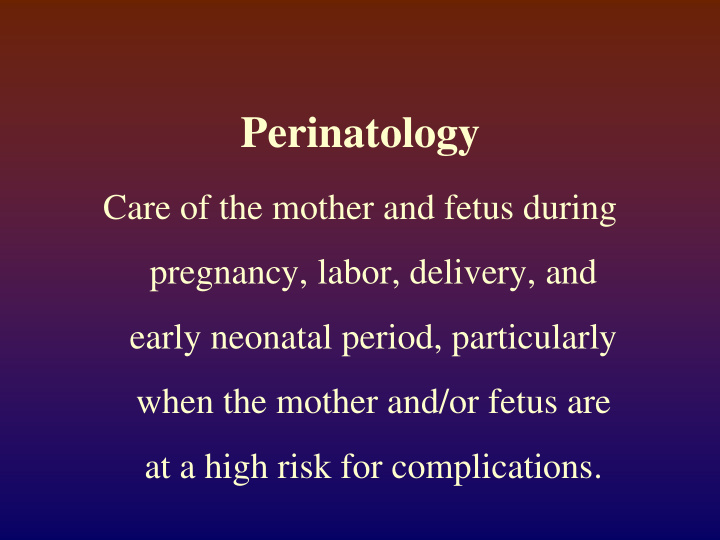



Perinatology Care of the mother and fetus during pregnancy, labor, delivery, and early neonatal period, particularly when the mother and/or fetus are at a high risk for complications.
Perinatology Perinatology in Human Medicine Origins of Veterinary Perinatology
High Risk Pregnancy History of previous problems Development of problems during current pregnancy
Perinatology What is the threat to the fetus/neonate? How can the threat be eliminated?
Fetal Resuscitation Identify the fetal problem Direct therapy at the problem’s source
High Risk Pregnancy Threats to Fetal Well-being Lack of placental perfusion Lack of O 2 delivery Nutritional threats Placentitis/placental dysfunction Loss of fetal/maternal coordination Iatrogenic factors Presence of a twin Idiopathic insults
Threats to Fetal Well-being Lack of Placental Perfusion Late term fetus High oxygen demand Must receive constant perfusion Margin of safety in late pregnancy small Maternal compromise Dehydration/Shock Decreased perfusion for any reason Placental response limited Compromised placental circulation Hypoxic ischemic insult
Fetal Resuscitation Maintenance of Placental Perfusion Aggressively treat hypovolemia in dam Aggressively treat hypotension in the dam Avoid anesthesia in late term mares
Threats to Fetal Well-being Lack of O 2 Delivery Maternal threats Maternal anemia Maternal hypoxemia Decreased perfusion Fetal response Unique aspect of placentation Placental oxygen transport mechanisms
Placentation
Placental Circulation
Equine Placentation From: Steven & Samuel (1975) J. Repro. Fert., Suppl. 23:579
Effect of Maternal Oxygen Therapy
Placental Blood Gas Transport Fetal Blood Oxygen Affinity Higher than maternal blood Umbilical blood becomes highly saturated Even at a low Po2 Fetal Hemoglobin - in ruminants Erythrocyte Concentration of 2,3-DPG (lower) Fetal pig Fetal Foal - small effect (2 torr)
Fetal Resuscitation Lack of O 2 Delivery Fetal hypoxemia - supplement with INO 2 Take advantage of the countercurrent system Even if normal Pao 2 in mare, foal may benefit Could be important with placental edema May see improved FHR parameters
Maternal Oxygen Therapy
Nutritional Threats Glucose Utilization The placenta Actively metabolic tissue High glucose utilized by placenta in horse Glucose for placenta also comes from fetus Maternal distress – less glucose More glucose delivered from fetus Can lead to negative net glucose transport to fetus
IUGR Intrauterine Growth Restriction
Threats to Fetal Well-being Nutritional Threats Chronic malnutrition of the dam Lack of intake Malabsorption Tumor cachexia Acute fasting of the dam Forced fasting Capricious appetite - late gestation
Threats to Fetal Well-being Nutritional Threat of Acute Fasting Fasting the mare for 30-48 hr Decreased glucose delivery Rise in plasma FFA Increased PG’s in uterine and fetal tissues Increased risk of preterm delivery Within one week of ending the fast Associated with myometrial sensitivity to hormones
Fetal Resuscitation Nutritional Threats Support the mare’s nutritional needs Enteral supplementation Parenteral supplementation Encourage a high plain of nutrition Avoid acute fasting Avoid elective procedures requiring fasting Encourage anorexic late term mares to eat If acute fasting is unavoidable – colic, anorexia Supplement with intravenous glucose therapy Consider flunixin meglumine therapy
Threats to Fetal Well-being Placentitis/Placental Dysfunction Premature placental separation Infection Inflammation Degeneration Edema Hydrops
Threats to Fetal Well-being Placentitis Percentage of abnormal placenta Not a predictor of fetal outcome Presence of abnormal placental tissue Is enough to cause serious problems Fetal foals born with placentitis More likely to have neonatal diseases
Fetal Resuscitation Placentitis/Placental Dysfunction Treat as infectious Trimethoprim potentiated sulfa drugs Try to minimize PG formation NSAIDs - flunixin meglumine Hormone supplementation therapy Altrenogest (ReguMate)
Threats to Fetal Well-being Iatrogenic Factors Early delivery Drugs Presence on a Twin Other peripartum hypoxic ischemic asphyxial events
Fetal Monitoring History Intrapartum fetal monitoring Rational decision to hasten parturition - C-section Explosive nature of parturition in the mare Prepartum fetal monitoring Allow prediction of intrauterine hypoxia and distress Result in effective fetal resuscitation Rational decision about early delivery
Early Udder Development Precocious Lactation Most reliable sign of fetal distress
Fetal Monitoring Biophysical Profile A collection of ultrasound derived observations Correlate with fetal health or fetal distress In man fetus with abnormal profiles Clearly in trouble In man fetus with normal profiles Usually normal May have life threatening hypoxemia, other problems Not sensitive enough for all problems
Fetal Monitoring Equine Biophysical Profile Fetal heart rate Fetal aortic diameter Maximum fetal fluid depths Utero-placental contact Utero-placental thickness Fetal activity
Fetal Monitoring Equine Biophysical Profile Not sensitive Fetus with normal profiles may be suffering from life threatening problems Not specific Occasionally extreme values in normal fetuses
Fetal Heart Rate Response
Fetal heart rate measurements Fetal ECG FHR = 48-52 MHR = 60 FHR = 136 - 158 - 130 MHR = 43-45
Fetal Resuscitation If Fetus Clearly in Distress Consider early induction, early delivery Oxytocin induction C-section These should be considered high risk procedures for the fetus and mare
No way back
More recommend